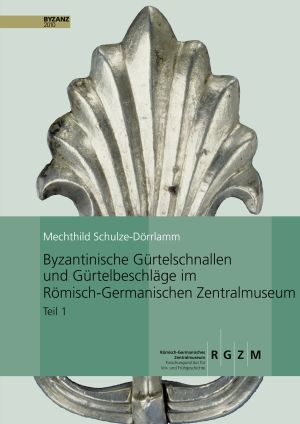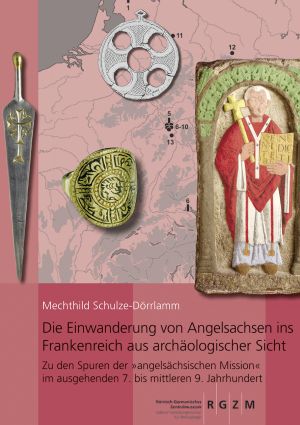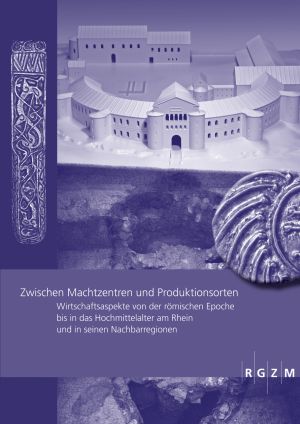Schulze-Dörrlamm, Mechthild
Byzantinische Gürtelschnallen und Gürtelbeschläge im Römisch-Germanischen Zentralmuseum: Die Schnallen ohne Beschläg, mit Laschenbeschläg und mit festem Beschläg des 5. bis 7. Jahrhunderts
Das Römisch-Germanische Zentralmuseum besitzt eine der weltweit größten Sammlungen byzantinischer Gürtelschnallen, die überwiegend aus dem Zentrum des Byzantinischen Reiches stammen. Selbst als Einzelstücke ohne Fundzusammenhang vermitteln sie wichtige Erkenntnisse über Form und Dekor dieses Kleidungszubehörs, das mehrheitlich von Männern – insbesondere von Soldaten – an ihrem Leibgurt getragen worden ist. Als deren Abzeichen lassen sie noch heute auf den Rang bzw. die soziale Stellung ihres Trägers schließen und etwas von dessen geistiger Vorstellungswelt erahnen.
Teil 1 des Kataloges, der 2002 erstmals erschienen ist und in dieser Neuauflage leicht korrigiert wurde, stellt 224 typische Gürtelschnallen des 5. bis 7. Jahrhunderts in ihrer Formenvielfalt und einstigen Verbreitung vor. Zudem erleichtert die Chronologietabelle am Schluss des Bandes eine rasche Bestimmung und Datierung von Neufunden. Der Leser besitzt zugleich einen Leitfaden, um typisch byzantinische Gürtelschnallen von zeitgenössischen Varianten aus Werkstätten in den Nachbarländern des Reiches unterscheiden zu können.
Die zweite Auflage ist eine überarbeitete Version, die um 33 neu erworbene Stücke ergänzt wurde.
Zu Band 2
Byzantinische Gürtelschnallen und Gürtelbeschläge im Römisch-Germanischen Zentralmuseum: Die Schnallen ohne Beschläg, mit Laschenbeschläg und mit festem Beschläg des 5. bis 7. Jahrhunderts
Das Römisch-Germanische Zentralmuseum in Mainz besitzt derzeit 363 byzantinische Gürtelschnallen und -beschläge des 7. bis frühen 11. Jahrhunderts. Sie stammen überwiegend aus dem Zentrum des Byzantinischen Reiches, in dem es kaum Gräberfelder mit Grabbeigaben und deshalb nur wenige Funde gibt. Daher schließen diese Schnallen eine große Lücke in unserer Kenntnis über dieses Kleidungszubehör – obwohl es sich ausnahmslos um Einzelstücke ohne Fundzusammenhang handelt.
Auch in Teil 2 des Kataloges werden Merkmale, Zeitstellung sowie Verbreitungsgebiete der verschiedenen Schnallentypen aufgezeigt, und eine Chronologietabelle erleichtert dem Leser die Datierung von Neufunden. Die Auswertung geht u.a. auf Fragen der Handwerks-, Handels- und Trachtgeschichte ein, sucht aber auch nach den einstigen Besitzern. Dies waren überwiegend Männer, die Schnallen nicht nur zum Verschluss ihres Leibgurtes benutzten, sondern zugleich auch als Abzeichen ihres Ranges, der an Metall und Dekor ablesbar war. Erstmals fanden sich darüber hinaus Indizien dafür, dass Frauen spätestens im 9. Jahrhundert begonnen haben, Gürtelschnallen auf geschlechtsspezifische Weise zu tragen.
In einem eigenen Beitrag schildert die Restauratorin M. Fecht ihre Untersuchungsergebnisse zur Herstellungstechnik und zur – meist verloren gegangenen – Farbigkeit byzantinischer Gürtelschnallen des 8. Jahrhunderts.
Als Ergänzung zu Teil 1 wurde außerdem in diesen Band ein Katalog von 33 nachträglich erworbenen Fundstücken aufgenommen.
Zu Band 1
Die Einwanderung von Angelsachsen ins Frankenreich aus archäologischer Sicht.: Zu den Spuren der »angelsächsischen Mission« im ausgehenden 7. bis mittleren 9. Jahrhundert
Im 8. Jahrhundert lag der Höhepunkt einer geistigen Bewegung, die viele hoch gebildete Männer sowie einige Frauen aus Angelsachsen dazu veranlasst hatte, auf den Kontinent auszuwandern. Deren Ziel war es, die heidnische Bevölkerung – insbesondere Friesen und die stammesverwandten Altsachsen – für das Christentum zu gewinnen oder deren religiöse Bildung zu verbessern. Vor allem im nördlichen und östlichen Frankenreich arbeiteten sie zeitlebens als Missionare, Priester, Mönche und Nonnen, Lehrer oder Lehrerinnen, teils auch als Gelehrte. Von den Teilnehmern an der „angelsächsischen Mission“ sind heute nur wenige allgemein bekannt, z. B. der in Friesland ermordete Erzbischof Bonifatius und der Missionar Willibrord von Echternach, weil es bisher fast unmöglich war, sich ein umfassendes Bild dieses Personenkreises zu verschaffen.
In dem reich illustrierten Buch werden erstmals 70 Männer und 15 Frauen, die nachweislich aus Angelsachsen eingewandert sind, mit ihren Namen und Lebensdaten vorgestellt. Es enthält überdies Grundrisspläne der von ihnen gegründeten Kirchen und Klöster, zeigt die heute noch erhaltenen Gegenstände aus ihrem Besitz und dokumentiert ihre Gräber sowie das einzigartige Bonifatius-Grabmal in Mainz. Fünf neue Verbreitungskarten zeigen nicht nur die Lage von Wirkungsstätten und Begräbnisplätzen der Einwanderer, sondern auch der heutigen Aufbewahrungsorte von Werken der angelsächsischen Kunst und des Kunsthandwerks sowie der Fundorte archäologischer Gegenstände angelsächsischer Herkunft im Frankenreich.
Byzantinische Goldschmiedearbeiten im Römisch-Germanischen Zentralmuseum
Das Römisch-Germanische Zentralmuseum in Mainz besitzt eine Sammlung byzantinischer Goldschmiedearbeiten, die bisher nur zu einem kleinen Teil publiziert wurde und deshalb weithin unbekannt ist. Da diese Kollektion von Schmuckstücken und Rangabzeichen neben Einzelfunden auch bemerkenswerte Ensembles und zudem einige Kopien von wertvollen, leider zerstörten Originalen enthält, wird sie nun erstmals einer breiten Öffentlichkeit zugänglich gemacht. Die Objekte sind in 49 Katalognummern erfasst. Sie stammen überwiegend aus den Kerngebieten des Byzantinischen Reiches, vereinzelt aber auch aus Regionen jenseits seiner Grenzen und überdies aus einem langen Zeitraum, der sich vom späten 5. bis zum 14./15. Jahrhundert erstreckt.
Besonders hervorzuheben sind zwei Schatzfunde, darunter sogar ein münzdatierter aus Kleinasien oder dem syro-palästinensischen Raum, mehrere Kettengehänge aus kunstvoll durchbrochenen Goldmedaillons, ein ebenfalls mit feinstem opus interrasile und zudem mit wertvollsten Edelsteinen verzierter Goldarmring aus Syrien, der einzige erhaltene Zierstreifen einer Frauenkronhaube, der reich ziselierte Taschendeckel eines Mannes von mutmaßlich königlichem Rang sowie ein Ensemble römischer Glasgefäße, die wohl in Konstantinopel im 8./9. Jahrhundert mit ziselierten Goldfolien beklebt worden sind und Antiquitäten aus dem dortigen Kaiserpalast sein könnten.
Außer einem Kurzkatalog mit knappen Angaben zu jedem Sammlungsobjekt enthält das Buch eine antiquarische Würdigung dieser Goldschmiedearbeiten und die numismatische Bearbeitung des münzdatierten Schatzfundes. Darüber hinaus findet man eine detaillierte Beschreibung aller angewandten Goldschmiedetechniken, die zwei erfahrene Goldschmiedinnen und Restauratorinnen in den Werkstätten des RGZM untersucht haben. Insgesamt ist der Katalog mit neuen Meisterfotos aller Preziosen und zahllosen Detailaufnahmen sowie mit Zeichnungen sehr viel reicher bebildert als vergleichbare Publikationen.
Zwischen Machtzentren und Produktionsorten: Wirtschaftsaspekte von der römischen Epoche bis in das Hochmittelalter am Rhein und in seinen Nachbarregionen
Am 12. November 2018 wurde in Ingelheim am Rhein ein Kooperationsabkommen zwischen der dort ansässigen Forschungsstelle Kaiserpfalz und dem Römisch-Germanischen Zentralmuseum, Leibniz-Forschungsinstitut für Archäologie, unterzeichnet. Damit wurden jene engen Verbindungen schriftlich verstetigt, die schon seit der Mitte des 19. Jahrhunderts zwischen den Mainzer Wissenschaftlern und den Erforschern der Ingelheimer Kaiserpfalz bestanden hatten. Im Fokus der zukünftigen Kooperation stehen besonders europäische Wirtschaftsaspekte und Themen der überregionalen Materialforschung. Erste Früchte dieser Zusammenarbeit konnten bei interdisziplinär angelegten Tagungen am 12. und 13. November 2018 in Ingelheim sowie am 28. und 29. November 2019 in Mayen vorgestellt werden. Diese Veranstaltungen dienten zugleich dem intensiven Austausch mit Wissenschaftlern aus dem In- und Ausland. Die Resultate beider Tagungen sind in diesem Tagungsband zusammengeführt. In 25 Fachbeiträgen werden die Grundlagen des Handels im Rheinland und seinen Nachbarregionen sowie die Vorgänge des Warenaustausches zwischen Machtzentren, ländlichen Regionen und Produktionsstätten im Zeitraum von der römischen Epoche bis in das Hochmittelalter aus ganz unterschiedlichen Blickwinkeln beleuchtet. Sowohl für die großräumigen Entwicklungstendenzen und die Beziehungen zwischen unterschiedlichen Wirtschaftsregionen als auch für die Produktionsstätten und die Vermarktungsrouten bieten die Beiträge richtungsweisende Ausführungen, grundlegende Darstellungen und außergewöhnliche Beschreibungen. Sie bilden die Basis für zukünftige Forschungen in an das Rheinland anschließenden Teilen Europas, die im Rahmen der Kooperation geplant sind und in weiteren Tagungen ihren Niederschlag finden sollen.











